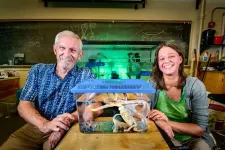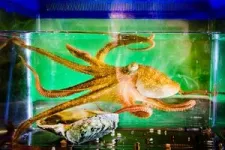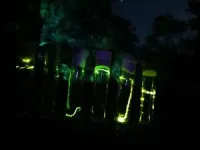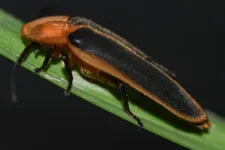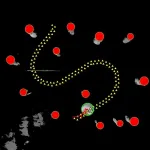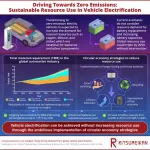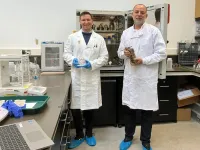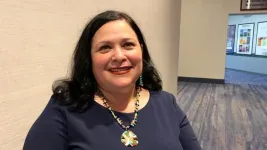(Press-News.org) CHAMPAIGN, Ill. — By giving artificial intelligence simple associative learning rules based on the brain circuits that allow a sea slug to forage — and augmenting it with better episodic memory, like that of an octopus — scientists have built an AI that can navigate new environments, seek rewards, map landmarks and overcome obstacles.
Reported in the journal Neurocomputing, the new approach gives AI the ability to explore and gather the information it needs to expand its spatial and temporal awareness, growing its knowledge base while learning on the job, said Ekaterina Gribkova, a postdoctoral researcher at the University of Illinois Urbana-Champaign who led the study with U. of I. molecular and integrative physiology professor emeritus Rhanor Gillette, with support from agricultural and biological engineering professor Girish Chowdhary.
“This essentially makes our artificial intelligence much more animal-like than current artificial intelligences,” Gribkova said. “We are learning how to go from something like the memory of a sea slug, which is very, very simple, to something like us.”
The new approach has the added advantage of being more efficient than the standard method of pretraining AI with vast amounts of data before it performs basic functions, she said.
By adding a memory module that allows the AI to retain information about past events, very simple spatial learning can be expanded to much more complex learning, Gribkova said.
“We can use the same types of associations to learn, for example, sequences of motor behaviors, or how to map social networks or even linguistic problem-solving,” she said. “Learning in the spatial domain, and actually navigating the environment making shortcuts, which our memory module is able to do, can be very well applied to more abstract concepts.”
To achieve this, the team built on their previous work simulating the decision-making neural circuits of a sea slug of the genus Pleurobranchaea, a project known as “Cyberslug.” They named their simulated creature ASIMOV, after Isaac Asimov, a science fiction writer who explored the safety concerns and ethics of robotics in human society.
The researchers programmed ASIMOV to monitor its own internal state and seek satiation and reward. When it was “hungry,” after not having eaten for a while, ASIMOV learned through trial and error to select nutritious over noxious food items. When the researchers added an intoxicating simulated drug to its range of options, ASIMOV behaved as if addicted, chasing after the drug even though it had no nutritional value.
ASIMOV lived in the moment, however, and while it could learn from experience, its memory and ability to integrate information from past experiences were limited. So Gribkova added a computational module for episodic memory, called the Feature Association Matrix, modeled on the architecture and functions of the hippocampus, a brain region essential to learning and memory. This work also was informed by studies of the brain networks that drive behavior in an octopus. The researchers called the ASIMOV-FAM agent a “CyberOctopus.”
“Episodic memory encodes both spatial and temporal contexts of past events and experience,” the authors wrote. This is a fundamental building block of natural intelligence, which most current AI models lack, they said.
In the new study, ASIMOV-FAM explored a simulated environment with various landmarks, some of which had rewards attached to them. Gribkova focused on pairwise associations that could be strengthened or weakened by weighing the relative rewards of each pathway ASIMOV took. It was programmed to seek out novelty and rewards.
“The ASIMOV agent uses cognitive maps formed by the FAM to learn its spatial environment,” Gillette said. “It can generate new paths and shortcuts for traversing the environment more efficiently, for greater rewards. This is effectively spatial reasoning.”
The researchers said they expect to use this new approach to create a more efficient and advanced AI that can perform a variety of tasks beyond spatial navigation.
“We expect ASIMOV-FAM can be adapted for more abstract, nonspatial applications, for instance, to enhance large language models like ChatGPT for more efficient computation and problem-solving, with reduced size and training requirements,” Gillette said.
“We’re thinking that if we can do more of a bottom-up approach, we can build an AI that doesn’t require all that much data, that’s a lot more animal-like in its adaptive behavior and creativity and that is learning more on its own,” Gribkova said. “In essence, we see advanced AI as learning much more like a child would learn.”
Gillette and Gribkova are affiliates of the Center for Artificial Intelligence Innovation at the National Center for Supercomputing Applications and in the Neuroscience Program at the U. of I. Gillette also is a professor in the Beckman Institute for Advanced Science and Technology and in the Carl R. Woese Institute for Genomic Biology at Illinois.
The U.S. Office of Naval Research supported this work.
Editor’s notes:
To reach Ekaterina Gribkova, email gribkov2@illinois.edu.
To reach Rhanor Gillette, email rhanor@illinois.edu.
The paper “Cognitive mapping and episodic memory emerge from simple associative
learning rules” is available online.
DOI: 10.1016/j.neucom.2024.127812
END
The leading hypothesis for the origin of firefly lights has been overturned by a genomic analysis. It had been posited that the bright lights emitted by many species in the Lampyridae family of beetles—better known as fireflies—first evolved as a warning signal to predators, advertising the toxicity of fireflies, and were then repurposed as a mating signal. This explanation would account for why eggs, larvae, and pupae also glow. Ying Zhen and colleagues put the conventional wisdom to the test by compiling a family tree of fireflies and tracing the evolution of the chemical compounds ...
ASAP Launches Data-Sharing Tool with Unique Dataset of Human Postmortem-Derived Brain Samples
Aligning Science Across Parkinson’s (ASAP) launched a platform to make high-value data for Parkinson’s disease broadly available to researchers all over the world
The platform launches with data from a unique human postmortem-derived brain sequencing collection, including samples from four ASAP Collaborative Research Network (CRN) teams and 156 donors
The database will continue to expand, with 629 donors contributing to the final harmonized dataset; there will be a consistent cadence of new ...
In 2018, Arthur Ashkin won the Nobel Prize in Physics for inventing optical tweezers: laser beams that can be used to manipulate microscopic particles. While useful for many biological applications, optical tweezers require extremely controlled, static conditions to work properly.
“Optical tweezers work by creating a light ‘hotspot’ to trap particles, like a ball falling into a hole. But if there are other objects in the vicinity, this hole is difficult to create and move around,” says Romain Fleury, head of the Laboratory of Wave Engineering in EPFL’s School ...
With goals to limit CO2 emissions, many countries have set targets to phase out internal combustion vehicles in favor of electric vehicles (EVs). Japan has set a target for 20-30% of all car sales to be battery electric vehicles (BEVs) and plug-in hybrid electric vehicles (PHEVs), and 30-40% of car sales to be hybrid electric vehicles (HEVs) by 2030. The USA plans for 50% of new vehicles to be zero-emission by 2030, while Germany wants to have 15 million EVs on the road by 2030. These goals raise concerns about the raw material demand for EVs. Batteries, which account for 50% of all resources consumed in BEV production, require ...
Trying to figure out whether someone has Alzheimer’s disease usually involves a battery of assessments—interviews, brain imaging, blood and cerebrospinal fluid tests. But, by then, it’s probably already too late: memories have started slipping away, long established personality traits have begun subtly shifting. If caught early, new pioneering treatments can slow the disease’s remorseless progression, but there’s no surefire way to predict who will develop the dementia associated with Alzheimer’s.
Now, Boston University researchers say they have designed a promising new artificial ...
If aliens modified a planet in their solar system to make it warmer, we’d be able to tell. A new UC Riverside study identifies the artificial greenhouse gases that would be giveaways of a terraformed planet.
A terraformed planet has been artificially made hospitable for life. The gases described in the study would be detectable even at relatively low concentrations in the atmospheres of planets outside our solar system using existing technology. This could include the James Webb Space Telescope, or a future European-led space telescope concept.
And ...
Researchers from Trinity College Dublin’s School of Natural Sciences have revealed a novel route to the formation of bastnäsite, a crucial mineral for the extraction of rare earth elements (REEs). Their work offers promise in one day making the extraction of these REEs more efficient.
The study – published today in the journal Nanoscale – uncovers for first time how fluocerite, a rare mineral, quickly forms and transforms into bastnäsite. The occurrence and origin of fluocerite in natural deposits was not fully understood, ...
ALBUQUERQUE, N.M. — The Department of Energy has once again awarded Sandia National Laboratories for its work helping small businesses. One of those businesses, owned by a disabled veteran, was also awarded for its extraordinary work.
DOE Mentor of the Year
Sandia’s small business Mentor-Protégé Program has been named as DOE Mentor of the year, an award it has received for three consecutive years.
Now in its fifth year, the program has mentored five protégés from around the country. More than 150 volunteer mentors and support personnel help these small and disadvantaged businesses grow, succeed and navigate doing business ...
PULLMAN, Wash. – Your mom might be a better health influencer than Dwayne “The Rock” Johnson.
Adults in a study who said they looked to a person they knew as role model for good health—such as a friend, relative or healthcare provider—rather than a celebrity, had greater motivation to reach their health goals. The women participants were also more likely than men to choose a personal role model rather than a celebrity. And the person most often named was their own mother.
“We know that parents have a huge influence on shaping people’s health trajectories throughout their life just ...
Giant lizards called heath goannas could save Australian sheep farmers millions of dollars a year by keeping blowfly numbers down - and must be prioritised in conservation schemes to boost native wildlife, say researchers.
A study led by the University of Cambridge has found that heath goannas - a species of giant, scavenging lizard - act as natural clean-up crews by clearing maggot-ridden animal carcasses from the landscape.
This reduces the emergence of blowflies, which attack sheep by laying eggs on their backsides that hatch into flesh-eating maggots. The disease, known as ‘fly strike’, costs the Australian sheep farming industry an estimated $280 million a year.
This ...
